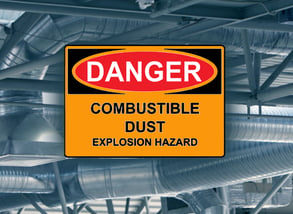 We’ve talked in the past about how when there is combustible dust in a facility it is usually safe to assume that there is more dust hidden inside the ductwork, creating a confined dust explosion hazard. Even with cleaning outside the ductwork, this hazard can stay hidden until it leads to a dust explosion.
We’ve talked in the past about how when there is combustible dust in a facility it is usually safe to assume that there is more dust hidden inside the ductwork, creating a confined dust explosion hazard. Even with cleaning outside the ductwork, this hazard can stay hidden until it leads to a dust explosion.
A cabinet making company in Minnesota discovered this the hard way on Thursday, November 10th when accumulated wood dust in the ductwork leading to their dust collector exploded. The resulting explosion injured three workers, but luckily their injuries are not life threatening.
The Sheriff’s office investigated the cause of the explosion, and found that a piece of machinery in the shop let off a spark, which was then sucked into the dust filled ductwork, resulting in the dust explosion.
The spark actually created a fire in the ductwork that led to the dust collection unit, which brought the local Fire, Rescue, and Sheriff’s Deputies to the scene, where the dust collector then exploded from the built up pressure and heat.
The Dust Explosion Pentagon shows that containment is one of the essential parts to creating the scenario for a combustible dust explosion, and the inside of ductwork creates the perfect environment for this to happen. Dirty ductwork can not only lower the efficiently of the air handler and increase operating costs, but as this shows, it can also create a safety and confined dust explosion risk.

